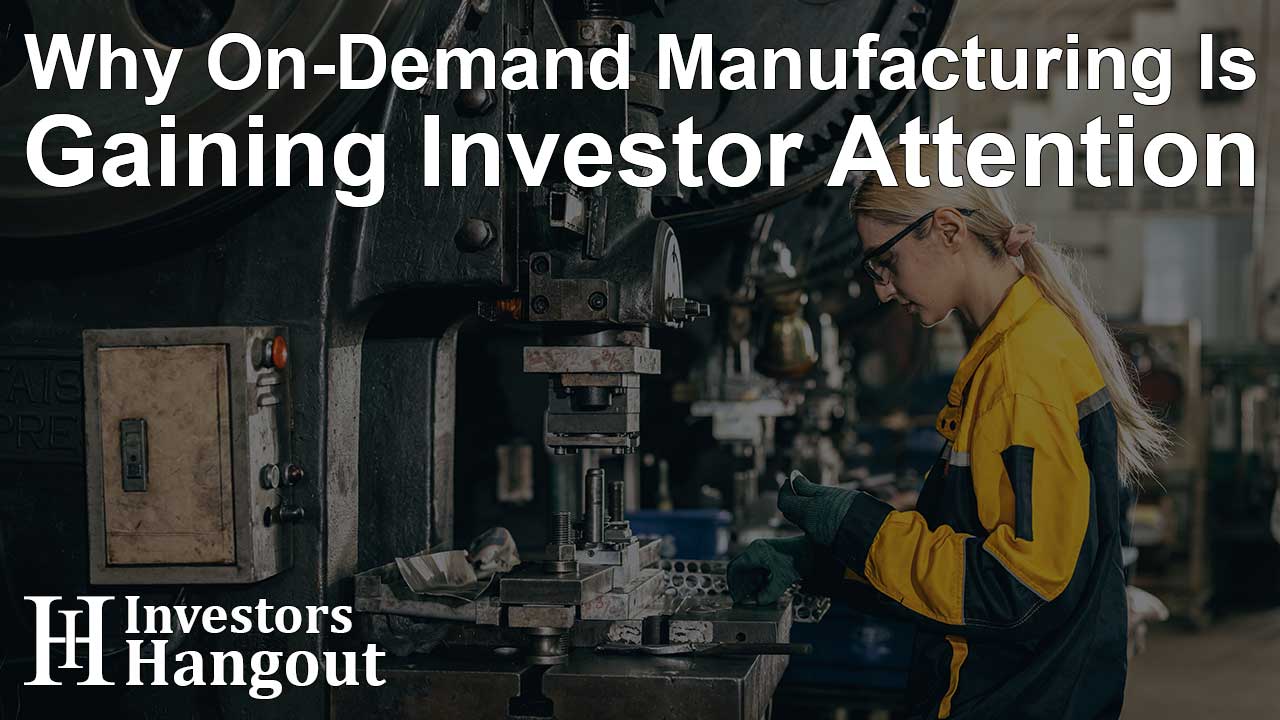Why On-Demand Manufacturing Is Gaining Investor Attention

Over the years, many have equated manufacturing with costly startup costs, complex supply chains, and mass production. Manufacturing companies set aside a large portion of their expenses for warehouses, materials, and tools that are needed for the continuous production of goods or products in bulk. While some manufacturers have become familiar and comfortable with such processes, others have effectively adapted to on-demand manufacturing - a more modern, efficient, flexible, and speedy alternative.
Like most modern processes, on-demand manufacturing makes use of advanced technological innovations that help make the manufacturing process easier. Unlike the traditional practice, this method not only helps businesses improve significant aspects of the manufacturing process - i.e., enhance responses to market demands, lessen or eliminate waste, and do away with excess inventories - but it also elevates the company’s chances of getting investors, thereby increasing the chances of growth.
On-demand manufacturing also helps businesses leverage the powers of cloud-based manufacturing platforms, 3D printing, and AI or artificial intelligence.
This article discusses the value, potential, and future of on-demand manufacturing.
The Rise of On-Demand Manufacturing
One of the biggest reasons for the rising success of on-demand manufacturing is the fact that traditional production processes have limitations. For example, a company that manufactures exercise equipment produces such products in bulk so it can reach its goal of high returns. Following a method that has been practiced for decades may feel comfortable, but it does not necessarily mean it works; it lengthens lead time, increases excessive inventory risk, and costs a lot in the long run. It’s not an attractive investment.
A business that uses on-demand manufacturing methods realizes the advantages of a process that allows it to enjoy a smooth, efficient, cost-saving production flow. They do not anticipate the demand for their products and then produce the goods in massive quantities. What on-demand manufacturing makes businesses do is produce goods only when there is a need, and only what is needed. Through the advanced technologies of 3D printing or additive manufacturing, CNC machining, and AI, companies won’t need to spend additional money and waste production time.
Businesses in the consumer electronics, healthcare, automotive, and aerospace technology industries can benefit from the highly efficient, low-cost, and speedy processes of on-demand technology. Regardless of what the product is, investors will find such businesses attractive and purposeful investments.
Key Drivers of Investor Interest
Scalability/Agility
The term “on-demand” equates to scalability because of the efficiency and speed with which businesses using on-demand manufacturing methods adjust to the constant demands and changes of the consumer market and its conditions. It does not follow the traditional method’s lengthy lead time and high cost requirement. Instead, it helps businesses to be precise in manufacturing their products, producing only what is needed when it is needed. As such, production is easy to scale down or up according to need. This not only enhances efficiency but also helps keep businesses secure from financial instabilities and other similar risks.
With this modern manufacturing method, businesses that prefer and rely on custom precision marketing can now easily cater to the evolving needs of their customers, including parts of any size or complexity.
Investors prefer businesses that can easily scale and adapt to economic changes, including fluctuations, without worrying about exceeding the inventory. These are strong, resilient, and agile businesses.
Waste Reduction and Cost Efficiency
In traditional manufacturing, when bulk production happens, the company spends a lot of time, effort, and money. Businesses also need to consider the high cost of storage facilities (when there is an inventory excess). If their product does not deliver the expected sales, they will have thrown away all their financial resources and end up with losses due to unsold stocks.
Using on-demand manufacturing, businesses can eliminate waste because they will be producing only what is needed. Materials are also optimized through the use of advanced techniques, such as 3D printing.
Companies should also ensure that their investment decisions promote the importance of sustainability. More and more investors are leaning towards businesses that value the environmental impact of their products.
Technological Advancements
Image by TheDigitalArtist on Pixabay
It’s important to prioritize investor interest in a company’s product, and technology is one of the key factors that can help in this aspect. It is always part of an investor’s requirement set for choosing businesses. As such, they give a high mark to those companies that embrace, adapt, and use advanced manufacturing technologies, specifically automation and AI innovations that help make the on-demand manufacturing method scalable, cost-effective, and highly efficient.
How do these advanced technologies generate attention and interest? How do they help businesses with their manufacturing needs? Simple, by optimizing products using AI or any similar technology. So if the business manufactures exercise equipment, they can use AI technology to make their products more efficient and satisfying for their clients - i.e., an AI-powered step counter or an AI-enhanced treadmill.
These technologies help make on-demand manufacturing more interesting to businesses of all sizes and types. Such companies are automatically considered investor potential and can significantly impact the global supply chain, making the manufacturing process more responsive, efficient, and faster.
Market Responsiveness and Customization
Today’s investors are no longer interested in manufacturers that offer bulk production for just one product. They now recognize the value of choosing businesses' mass customization at scale using advanced technologies. The traditional method was to customize production using multiple design and tooling adjustments for every product. It had several limitations and took longer to complete.
With on-demand manufacturing, there are no barriers to the customization process and businesses have several technologies to use without having to spend extra for anything. The most important ones are automated CNC machining, 3D printing, and the use of AI-powered digital design tools. The healthcare industry benefits from this feature as it allows the personalization of medical devices and prosthetics according to the needs of individual patients. Exercise equipment manufacturers also require personalization in the products they create, as they need to cater to specific fitness categories. Another sector that can benefit from this capability is the consumer goods sector, where there is a high demand for personalized products, such as bespoke products, customized gym equipment, and even personalized water tumblers.
Businesses that provide on-demand customization are always a step ahead of the competition, and investors know this. These companies can easily adhere to the constantly evolving preferences of consumers, so they can deliver high-quality products that are made-to-order, unique, and fitted to the customers’ needs. This is a major reason why investments are pouring in for on-demand manufacturing businesses.
An Expanding Market and Future Potential
Image by TheInvestorPost on Pixabay
Contrary to what some may think, on-demand manufacturing is not a niche innovation—is an important development and a growing, expanding market. Industry reports indicated that it will continue to develop, grow, and improve in the next decade, all thanks to continuous advancements in AI technology, digital supply chain solutions, and automation, among others. Regardless of the size of the company (startup, mid-level, established, or enterprise), manufacturers are constantly adapting new technologies, streamlining operations, and enhancing their capabilities, even increasing their capital to do so.
There are multiple significant players in this aspect, including specialized production hubs and digital marketing platforms that lure investors or venture capitalists, companies that want to integrate on-demand manufacturing into their current systems, and private equity investors. Furthermore, some businesses have started using cloud-based marketing networks, which improve the manufacturing sector’s growth potential as companies can now use efficient global production resources without having to significantly increase overhead costs or capital.
It is understandable, though, that many businesses are still struggling to transform from the traditional to on-demand manufacturing method because of the required infrastructure and technology investment. The company’s entire workforce should also be properly trained. In some industries, the challenges are focused more on regulatory issues and supply chain disruptions. Some industries may also have scalability limitations. However, this does not stop technology from evolving, improving, and spreading throughout various sectors. The challenges and hurdles are only “beginner pains”. In the long run, businesses will be able to adapt the method smoothly and benefit from on-demand manufacturing even as the years go on.
Conclusion
On-demand manufacturing has attracted a lot of businesses and investors and has slowly transformed the global production schene. It offers a results-efficient, effective, agile, innovative, and cost-efficient solution for businesses that want to do away with the time- and resources-consuming traditional manufacturing method. It allows mass customization, lessens or eliminates waste, flexibility, and scalability - which are all attractive to investors.
Since it is a continuously evolving method, on-demand manufacturing will continue to grow, improve, and advance. As such, it offers long-term manufacturing solutions to businesses of all types and sizes. It is also a technology-forward alternative because it uses tech-driven platforms or models, such as AI and automation. There are challenges, yes, but the technologies behind it continue to evolve, so it will only improve as its demand grows.
Businesses and investors alike recognize the potential of on-demand manufacturing and they are finding ways to capitalize on this advantage in the best way possible.
About The Author
Contact Henry Turner privately here. Or send an email with ATTN: Henry Turner as the subject to contact@investorshangout.com.
About Investors Hangout
Investors Hangout is a leading online stock forum for financial discussion and learning, offering a wide range of free tools and resources. It draws in traders of all levels, who exchange market knowledge, investigate trading tactics, and keep an eye on industry developments in real time. Featuring financial articles, stock message boards, quotes, charts, company profiles, and live news updates. Through cooperative learning and a wealth of informational resources, it helps users from novices creating their first portfolios to experts honing their techniques. Join Investors Hangout today: https://investorshangout.com/
